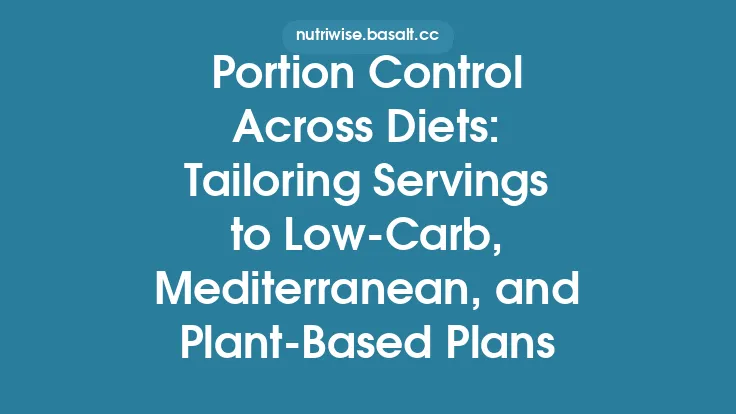The Mediterranean diet has become one of the most studied and celebrated eating patterns worldwide, not only for its rich culinary heritage but also for its robust evidence base linking it to a wide array of health benefits. Rooted in the traditional cuisines of countries bordering the Mediterranean Sea, this dietary model emphasizes whole, minimally processed foods, a balanced intake of macronutrients, and a lifestyle that integrates regular physical activity and communal meals. Below, we explore the foundational principles that define the Mediterranean diet, dissect its nutrient composition, and examine the biological mechanisms that translate these dietary choices into measurable health outcomes.
Core Principles of the Mediterranean Diet
- Abundance of Plant‑Based Foods
- Vegetables and fruits are consumed daily, providing fiber, vitamins, minerals, and a spectrum of phytochemicals.
- Legumes (beans, lentils, chickpeas) serve as primary sources of plant protein and complex carbohydrates.
- Whole grains (e.g., barley, farro, whole‑wheat bread, couscous) replace refined grains, delivering sustained energy and additional fiber.
- Healthy Fats as the Primary Energy Source
- Extra‑virgin olive oil is the cornerstone fat, rich in monounsaturated fatty acids (MUFA) and phenolic compounds.
- Nuts and seeds (almonds, walnuts, pistachios, sunflower seeds) contribute polyunsaturated fatty acids (PUFA) and bioactive micronutrients.
- Moderate Consumption of Fish and Seafood
- Fatty fish (e.g., sardines, mackerel, salmon) are eaten at least twice weekly, supplying long‑chain omega‑3 fatty acids (EPA/DHA) essential for cardiovascular and neural health.
- Limited Intake of Red and Processed Meats
- Red meat is reserved for occasional consumption, while processed meats are minimized to reduce saturated fat and sodium exposure.
- Dairy in Modest Quantities
- Fermented dairy (yogurt, kefir, cheese such as feta or pecorino) is incorporated in small portions, offering calcium, probiotics, and protein.
- Herbs, Spices, and Flavor Enhancers
- Culinary herbs (oregano, basil, rosemary, thyme) and spices replace excess salt, adding antioxidant polyphenols and enhancing satiety.
- Wine in Moderation (Optional)
- When culturally appropriate, red wine is consumed with meals, typically no more than one glass per day for women and two for men, contributing polyphenols like resveratrol.
- Lifestyle Integration
- Physical activity, social eating, and mindful eating practices are integral, reinforcing the diet’s holistic health impact.
Key Food Groups and Typical Meals
| Food Group | Representative Items | Typical Serving Frequency |
|---|---|---|
| Vegetables | Tomatoes, leafy greens, peppers, eggplant, zucchini | Daily (≥ 2–3 servings) |
| Fruits | Citrus, grapes, figs, pomegranates, berries | Daily (≥ 2 servings) |
| Legumes | Chickpeas, lentils, white beans, black-eyed peas | 3–4 times/week |
| Whole Grains | Whole‑wheat pita, barley, bulgur, farro | Daily (≥ 3 servings) |
| Nuts & Seeds | Almonds, walnuts, pistachios, sesame seeds | 4–5 times/week |
| Olive Oil | Extra‑virgin olive oil (cold‑pressed) | Primary cooking/fat source |
| Fish & Seafood | Sardines, anchovies, mussels, shrimp | ≥ 2 servings/week |
| Dairy | Greek yogurt, kefir, feta cheese | 1–2 servings/day |
| Herbs & Spices | Basil, oregano, garlic, cumin, sumac | Used liberally |
| Wine (optional) | Red wine | ≤ 1–2 glasses/week (if consumed) |
A classic Mediterranean lunch might consist of a mixed greens salad dressed with olive oil and lemon, a side of whole‑grain couscous studded with chickpeas and roasted vegetables, a portion of grilled fish, and a small serving of fresh fruit for dessert. Dinner could feature a vegetable‑rich ratatouille, a slice of whole‑grain bread, a modest portion of cheese, and, optionally, a glass of red wine.
Nutrient Profile and Bioactive Compounds
- Monounsaturated Fatty Acids (MUFA): Predominantly oleic acid from olive oil, which improves lipid profiles by lowering LDL‑cholesterol while preserving HDL‑cholesterol.
- Polyunsaturated Fatty Acids (PUFA): EPA and DHA from fish, and α‑linolenic acid (ALA) from nuts and seeds, exert anti‑inflammatory effects.
- Dietary Fiber: Soluble and insoluble fiber from legumes, whole grains, fruits, and vegetables supports gut microbiota diversity and glycemic control.
- Polyphenols: Hydroxytyrosol, oleuropein, and flavonoids from olive oil, wine, and plant foods act as potent antioxidants.
- Vitamins & Minerals: High levels of vitamin C, vitamin E, folate, potassium, magnesium, and calcium contribute to overall metabolic health.
- Probiotics & Prebiotics: Fermented dairy and fiber‑rich plant foods foster a beneficial gut microbiome, influencing immune function and metabolic pathways.
Mechanisms Underlying Health Benefits
- Lipid Modulation – MUFA and PUFA replace saturated fats, reducing hepatic synthesis of atherogenic lipoproteins and enhancing reverse cholesterol transport.
- Anti‑Inflammatory Action – Omega‑3 fatty acids and polyphenols down‑regulate pro‑inflammatory cytokines (e.g., IL‑6, TNF‑α) and inhibit NF‑κB signaling.
- Oxidative Stress Mitigation – Antioxidant compounds scavenge free radicals, protecting endothelial cells and neuronal membranes from oxidative damage.
- Gut Microbiota Optimization – High fiber intake promotes short‑chain fatty acid (SCFA) production (butyrate, propionate), which improves gut barrier integrity and insulin sensitivity.
- Endothelial Function Enhancement – Nitric oxide bioavailability is increased through polyphenol‑mediated eNOS activation, improving vasodilation.
- Satiety and Energy Balance – The combination of fiber, protein, and healthy fats prolongs post‑prandial satiety, aiding weight management.
Cardiovascular Health
Robust epidemiological data and randomized controlled trials (e.g., the PREDIMED study) demonstrate that adherence to the Mediterranean diet reduces the incidence of major cardiovascular events by approximately 30 % compared with low‑fat control diets. Specific outcomes include:
- Lower LDL‑C and triglycerides while maintaining or modestly increasing HDL‑C.
- Reduced blood pressure through improved endothelial function and sodium‑sparing effects of potassium‑rich foods.
- Decreased incidence of myocardial infarction, stroke, and cardiovascular mortality across diverse age groups.
Metabolic and Weight Management
- Improved Insulin Sensitivity: The low glycemic load of whole grains and legumes, combined with MUFA and PUFA, attenuates post‑prandial glucose spikes.
- Reduced Risk of Type 2 Diabetes: Longitudinal cohorts show a 20–30 % lower risk of developing diabetes among high‑adherence participants.
- Weight Maintenance: The diet’s emphasis on nutrient‑dense, satiating foods supports a modest caloric deficit without restrictive eating, facilitating sustainable weight control.
Neurocognitive and Mental Health
Emerging evidence links Mediterranean dietary patterns to:
- Preservation of Cognitive Function: Higher adherence correlates with slower rates of cognitive decline and reduced risk of Alzheimer’s disease, likely mediated by anti‑inflammatory and antioxidant mechanisms.
- Mood Regulation: Omega‑3 fatty acids and polyphenols influence neurotransmitter pathways (serotonin, dopamine) and may lower the prevalence of depressive symptoms.
Longevity and Disease Prevention
Population studies across Mediterranean countries consistently report higher life expectancy and lower prevalence of chronic diseases such as certain cancers (colorectal, breast) and metabolic syndrome. The synergistic effect of diet, physical activity, and social cohesion appears to create a protective milieu against age‑related pathologies.
Practical Guidelines for Adoption
- Swap Refined Oils for Extra‑Virgin Olive Oil – Use olive oil for sautéing, dressings, and drizzling over finished dishes.
- Prioritize Plant‑Based Meals – Aim for at least five servings of vegetables and fruits daily; incorporate legumes into soups, stews, and salads.
- Choose Whole Grains – Replace white rice and refined pasta with whole‑grain alternatives; experiment with ancient grains like farro or bulgur.
- Integrate Fish Regularly – Plan fish or seafood meals at least twice per week; consider canned sardines or anchovies for convenience.
- Limit Red Meat – Reserve red meat for special occasions; opt for lean cuts and smaller portions when consumed.
- Include Nuts and Seeds – Keep a small container of mixed nuts for snacks; sprinkle seeds on yogurt or salads.
- Flavor with Herbs and Spices – Build flavor profiles using fresh herbs, garlic, lemon zest, and spices rather than relying on salt.
- Mindful Portion Sizes – Use the “plate method”: half vegetables, a quarter whole grains or legumes, and a quarter protein (fish, poultry, or plant‑based).
- Enjoy Meals Socially – Share dishes with family or friends, emphasizing slower eating and conversation.
- Stay Active – Complement dietary habits with regular moderate‑intensity exercise (e.g., walking, cycling) for at least 150 minutes per week.
Cultural and Lifestyle Context
The Mediterranean diet is more than a list of foods; it reflects a cultural paradigm where meals are communal events, cooking is an art, and the environment (sunny climate, access to fresh produce) shapes food choices. Seasonal eating, reliance on locally sourced ingredients, and traditional preservation methods (e.g., drying tomatoes, fermenting olives) reinforce sustainability and food security. Understanding these cultural underpinnings can enhance adherence and appreciation for the diet’s holistic benefits.
Potential Considerations and Misconceptions
- Caloric Density of Olive Oil and Nuts: While healthful, these foods are energy‑dense; portion control is essential for weight management.
- Wine Consumption: Alcohol is optional; individuals with contraindications (e.g., pregnancy, certain medications) should abstain.
- Food Accessibility: In non‑Mediterranean regions, sourcing authentic ingredients may be challenging; however, the core principles can be applied using locally available equivalents (e.g., other high‑MUFA oils, regional legumes).
- Not a “Quick‑Fix” Diet: The long‑term health benefits arise from sustained adherence and integration with an active lifestyle, not from short‑term restriction.
By embracing the Mediterranean diet’s core principles—plentiful plant foods, healthy fats, moderate fish intake, limited red meat, and a lifestyle that values social connection and physical activity—individuals can tap into a time‑tested nutritional framework that supports cardiovascular health, metabolic balance, cognitive vitality, and overall longevity. The diet’s flexibility, cultural richness, and strong scientific foundation make it a compelling model for anyone seeking a sustainable, health‑promoting way of eating.





